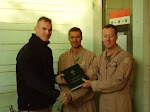( N.B. Lengthy but rich and dense with spiritual insight and pastoral truth. Worth reading especially for priests.)
In face of the decrease in the number of priests and the free fall in the number of seminarians.
 |
| Courtyard of the Metropolitan Seminary of the Immaculate Conception Buenos Aires, Argentina (Villa Devoto) |
On numerous occasions I have referred to a crucial issue for the Church: the formation of candidates for the priesthood. Today, I do it once again, without pretending, of course, to exhaust the subject, with this article. And I do so on the twentieth anniversary of the departure of St. John Paul II, who lived his seminary life “clandestinely” because of Nazism and Communism that ravaged his native Poland. And who, as Pope, together with the then Cardinal Joseph Ratzinger -later his successor, Benedict XVI- did so much to repair, in part, the mess of the post-conciliar period.
The decrease in the number of priests (406,996, worldwide, in 2023; 734 fewer than in 2022, according to official figures of the Holy See) is worrying; as is the free fall in the number of seminarians (according to the same Vatican statistics, there has been a steady decline since 2012; and it went from 108,481, in 2022, to 106,495, in 2023). On the other hand, the number of bishops increased from 5353 in 2022 to 5430 in 2023. In Rome's haste “to leave everything well tied up” for the times to come, friends of the same stripe continue to be appointed. The sterility typical of progressivism with regard to priestly vocations does not seem to apply to episcopal vocations. Especially if -despite the persistent criticisms of “careerism”- they come from known climbers.
I entered the Major Seminary of the Immaculate Conception, of the Archdiocese of Buenos Aires, during the sessions of the Second Vatican Council. While still a young priest, I was entrusted with the organization of the Diocesan Seminary of San Miguel, in the suburbs of Buenos Aires, and I was its rector for a decade. I left there when St. John Paul II appointed me auxiliary bishop of the unforgettable Cardinal Antonio Quarracino, in Buenos Aires. As coadjutor and as Archbishop of La Plata I visited the “St. Joseph” Major Seminary on a weekly basis; on Saturdays I offered a conference and then celebrated Mass. In those interventions I explained, over the course of a year, the decree Presbyterorum ordinis, on the life and ministry of priests; I did it twice in that extensive period of twenty years of service in the archdiocese. I always spent my vacations in February with the seminarians at the “San Ramon” country house in Tandil, so I had time to speak at length with each one of them. On the other hand, during the year I was available at their request, whenever they wanted or needed to see me. As a professor at the Faculty of Theology of the Catholic University of Argentina, I was given the opportunity to deal with candidates to the priesthood, from different dioceses, who were studying there.
I have studied extensively the above-mentioned conciliar document, as well as the decree Optatam totius, on priestly formation. I indicate this personal background because assiduous reflection and varied experience enable me, at this point in my life, to attempt a synthesis on priestly formation according to Vatican II. And also to propose, for the future, in the face of the present vocation crisis, ways to overcome it.
***
More: https://rorate-caeli.blogspot.com/2025/04/the-crisis-of-church-what-to-do-about.html











No comments:
Post a Comment